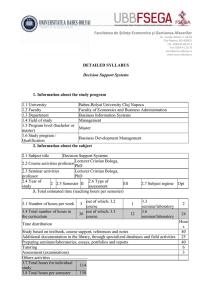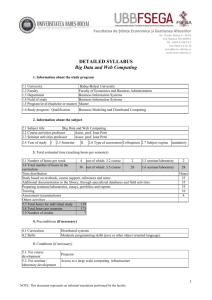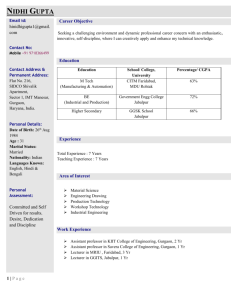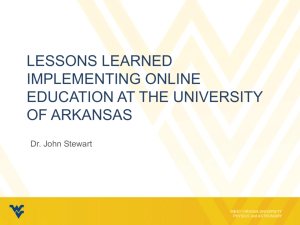ENCH 371 - Chemical and Process Engineering
advertisement
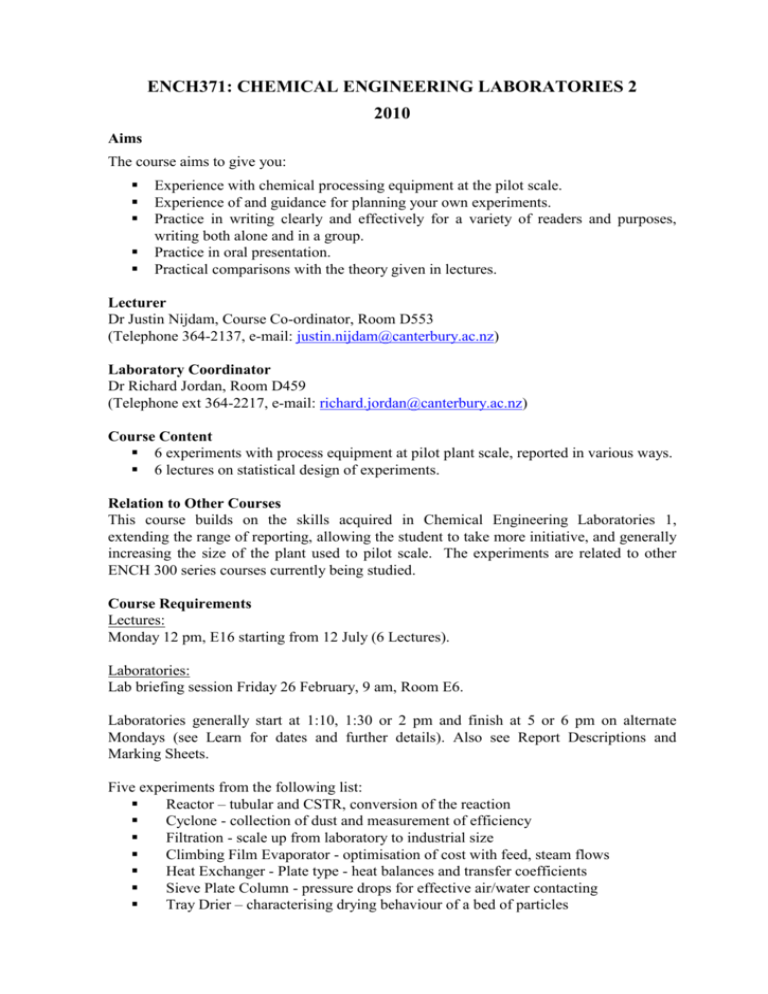
ENCH371: CHEMICAL ENGINEERING LABORATORIES 2 2010 Aims The course aims to give you: Experience with chemical processing equipment at the pilot scale. Experience of and guidance for planning your own experiments. Practice in writing clearly and effectively for a variety of readers and purposes, writing both alone and in a group. Practice in oral presentation. Practical comparisons with the theory given in lectures. Lecturer Dr Justin Nijdam, Course Co-ordinator, Room D553 (Telephone 364-2137, e-mail: justin.nijdam@canterbury.ac.nz) Laboratory Coordinator Dr Richard Jordan, Room D459 (Telephone ext 364-2217, e-mail: richard.jordan@canterbury.ac.nz) Course Content 6 experiments with process equipment at pilot plant scale, reported in various ways. 6 lectures on statistical design of experiments. Relation to Other Courses This course builds on the skills acquired in Chemical Engineering Laboratories 1, extending the range of reporting, allowing the student to take more initiative, and generally increasing the size of the plant used to pilot scale. The experiments are related to other ENCH 300 series courses currently being studied. Course Requirements Lectures: Monday 12 pm, E16 starting from 12 July (6 Lectures). Laboratories: Lab briefing session Friday 26 February, 9 am, Room E6. Laboratories generally start at 1:10, 1:30 or 2 pm and finish at 5 or 6 pm on alternate Mondays (see Learn for dates and further details). Also see Report Descriptions and Marking Sheets. Five experiments from the following list: Reactor – tubular and CSTR, conversion of the reaction Cyclone - collection of dust and measurement of efficiency Filtration - scale up from laboratory to industrial size Climbing Film Evaporator - optimisation of cost with feed, steam flows Heat Exchanger - Plate type - heat balances and transfer coefficients Sieve Plate Column - pressure drops for effective air/water contacting Tray Drier – characterising drying behaviour of a bed of particles Spray Drier – water balances and drying rates of milk droplets Non Newtonian Flow - small tube viscometry for prediction of flow in large tubes Level Dynamics - modelling the filling and emptying of tanks Refrigeration - determining the thermodynamic efficiency Mixing – rates of dissolution of a suspended soluble particle Dissolving Oxygen – oxygen transfer in an air-bubbled stirred tank Plus a compulsory experiment - Process Dynamics - stirred tank heating response. Workload 6 experiments with contact time 3-6 hours each, time of report preparation 10-25 hours for different report styles, total 125 hours. 6 lectures on statistical design of experiments, total 15 hours. Assessment Design of Experiments: Assignment (worth 1%) due 16 August 12 pm Test (40 minutes, worth 7%) 16 August 12 pm Laboratories: Six reports will be completed (each worth 13% except the formal report, which is worth 27%): Two Management Reports - reports to management (one week to hand in) Poster - on A3 sheet, large print, brevity, clarity and presentation important (one week to hand in) Same-day Report - a rapidly-executed industrial report to immediate superior (same evening hand-in) Process Dynamics – in the style of the Management Report (done as a group) Formal Report - full experiment including a research component, in which experience drawn from a previous experiment and reports of other students who have done the same experiment are used to improve on that experiment in some fashion. First draft two or three weeks after lab, then draft back with corrections after oral presentation in first week of 4th term. Report to be submitted on Monday of Week 2 of Term 4. Material Text book: Montgomery, D.C., Runger, G.C., 2007, Applied Statistics and Probability for Engineers, 4th Edition, John Wiley & Sons. Recommended: Kirkup, L, 1994, Experimental Methods - An Introduction to the Analysis and Presentation of Data. John Wiley & Sons. This is a useful guide for working on your lab results. See the various lab information sheets, available on Learn. These information sheets also detail library sources. Coleman, S., 1996, The Pocket Statistician, Wiley. (Especially Chapter 4 “Why design experiments?”)







